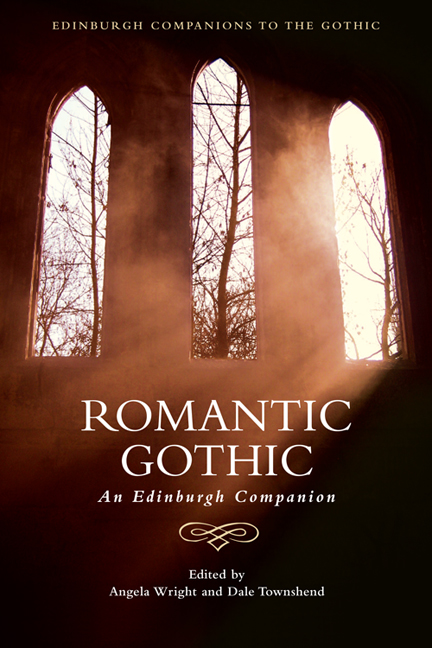Book contents
- Frontmatter
- Contents
- 1 Gothic and Romantic: An Historical Overview
- Part I Gothic Modes and Forms
- Part II National and International Borders
- 11 Gothic Borders: Scotland, Ireland and Wales
- 12 Gothic Travels
- 13 The Romantic and the Gothic in Europe: The Elementary Spirits in France and Germany as a Vehicle for the Transmission and Development of the Fantastique, 1772–1835
- 14 American Gothic Passages
- Part III Reading the Romantic Gothic
- Notes on Contributors
- Index
13 - The Romantic and the Gothic in Europe: The Elementary Spirits in France and Germany as a Vehicle for the Transmission and Development of the Fantastique, 1772–1835
from Part II - National and International Borders
Published online by Cambridge University Press: 05 August 2016
- Frontmatter
- Contents
- 1 Gothic and Romantic: An Historical Overview
- Part I Gothic Modes and Forms
- Part II National and International Borders
- 11 Gothic Borders: Scotland, Ireland and Wales
- 12 Gothic Travels
- 13 The Romantic and the Gothic in Europe: The Elementary Spirits in France and Germany as a Vehicle for the Transmission and Development of the Fantastique, 1772–1835
- 14 American Gothic Passages
- Part III Reading the Romantic Gothic
- Notes on Contributors
- Index
Summary
France: Rococo into Fantastique: Cazotte and the Elementary Spirits
The closest equivalent in French literary criticism to the English term ‘Gothic’, used in its broadest generic sense, is le Fantastique, and the most significant threshold text in the later eighteenth century for the Fantastique is Cazotte's Le Diable amoureux (1772). Cazotte combines ‘le bon ton’ – the lightness, elegance and clarity of a plain French aristocratic style – with the sinister, the dark and the disturbing. Max Milner, Cazotte's modern editor, calls it the ‘premier exemple dans notre littérature, d'un récit qui joue avec illusion en même temps qu'avec la peur, c'est-à-dire d'un récit fantastique’ [‘the first example in our literature of a narrative which plays at the same time with illusion and with fear; that is, a narrative of the fantastic’ (Cazotte 1979: 24, my translation)]. This short novel is set in Naples and is narrated in a deceptively confessional, dramatised first person by Alvare, a fiery young Spanish Captain of the Royal Guards, who falls in with some Cabbalists, and is dared to call up the Devil. He boasts that he will pull his ears. They lead him down into an underground chamber in the ruins of the ancient Portici and, after the requisite drawing of a pentacle and the casting of spells, the Devil appears in the form of an enormous and hideous camel's head, who asks in a huge voice that echoes through all the caverns: ‘Che vuoi?’ [‘What do you want?’]. Alvare is struck with terror, but masters his fear with pride, and, addressing him as ‘slave’, orders him to assume a more pleasing form – say, that of a spaniel. He lengthens out his snout to a sixteen-foot tube and vomits out a small white dog, whose ears are dragging on the ground. As Alvare bends down to pull those ears, the spaniel rolls over on its back, the text tells us, ‘comme pour me demander grâce’ (Cazotte 1979: 60) [‘as though to ask forgiveness’ (Landry 1991: 36)] and he sees it is a female, whom he names, on the spot, Biondetta (i.e. ‘little blonde’). Blinded by the surprise knowledge, Alvare starts back and forgives the spaniel.
- Type
- Chapter
- Information
- Romantic GothicAn Edinburgh Companion, pp. 247 - 266Publisher: Edinburgh University PressPrint publication year: 2015



